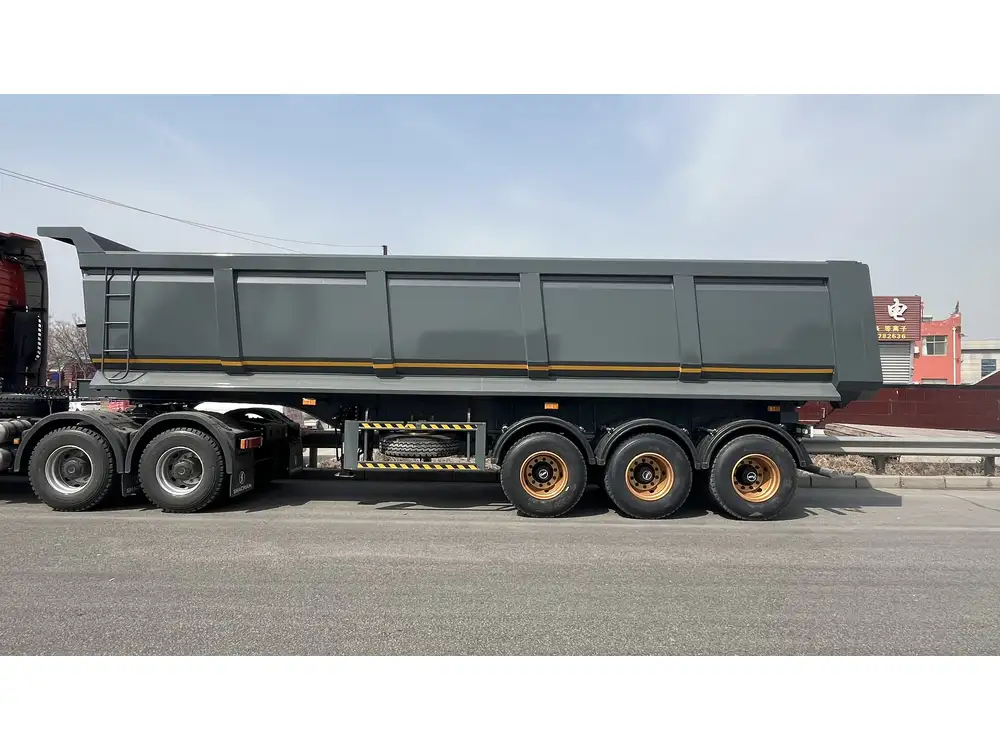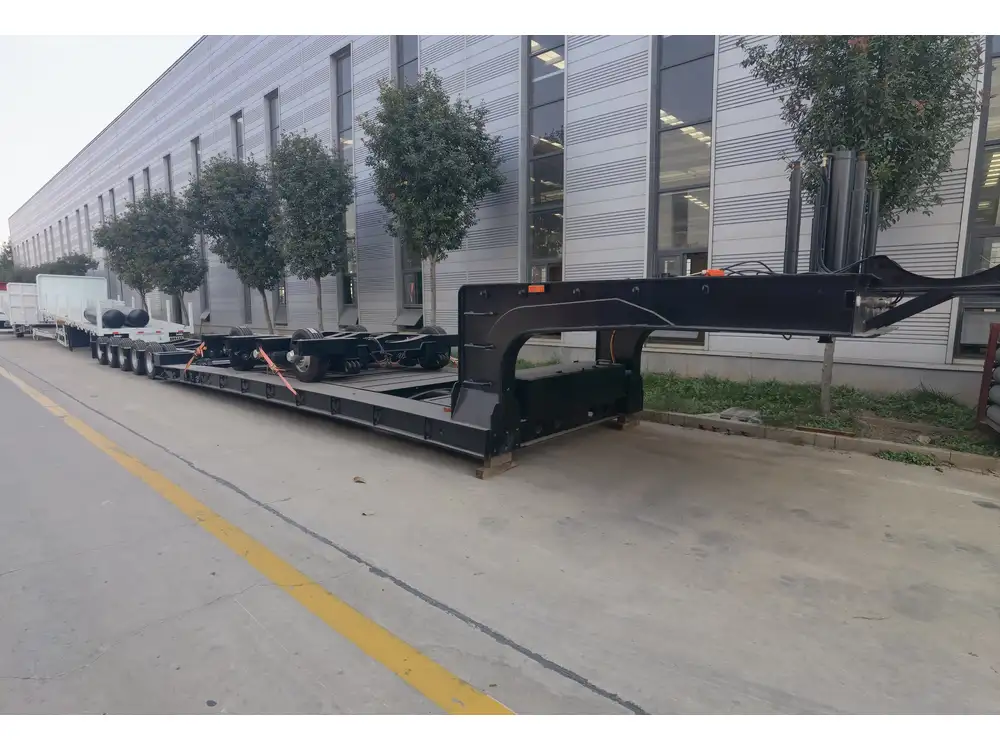Introduction: The Importance of Knowing Semi Truck Trailer Lengths
When it comes to the logistics industry, understanding the specifications of semi-trailers is of paramount importance. The length of a semi truck trailer not only influences the load capacity but also affects the overall design of transportation logistics, regulatory compliance, and operational efficiency. In the vast arena of freight hauling, where precision and reliability are critical, knowing the dimensions of semi truck trailers is essential for manufacturers, operators, and fleet managers alike.
Standard Semi Truck Trailer Lengths

1. Common Trailer Lengths
In the United States, the length of semi-truck trailers is typically categorized into a few standard measurements. Here’s a breakdown of the most common types:
| Trailer Type | Standard Length |
|---|---|
| Dry Van | 48 to 53 feet |
| Reefer (Refrigerated) | 48 to 53 feet |
| Flatbed | 48 to 53 feet |
| Tanker | 48 to 53 feet (varies) |
| Lowboy (Heavy Haul) | 20 to 53 feet |
The most frequently used length for over-the-road trailer transport is 53 feet, which accommodates larger freight loads while staying within industry regulations.
2. Regulatory Restrictions
Understanding trailer lengths also requires familiarity with the regulations enacted by the Federal Motor Carrier Safety Administration (FMCSA) and various state regulations. Specific limitations can vary based on geographic locations:
- Interstate Highways: Generally allow a maximum trailer length of 53 feet.
- State Roads: May impose additional restrictions, particularly on trailers exceeding 48 feet.
3. Alternative Lengths and Regulations
Certain configurations and types may also necessitate specific lengths. Specialty trailers, such as those used for oversized or heavy cargo, may exceed standard measurements. Here are some noteworthy examples:
| Specialty Configurations | Typical Lengths |
|---|---|
| LTL (Less-than-Truckload) | 28 to 45 feet |
| Extended Length Double Trailers | 61.5 feet |
| Auto Transport Trailers | 52 to 53 feet |
| Extended Flatbeds | Up to 60 feet |
It is crucial to check local regulations since states may have unique limitations, especially concerning double trailers or specialized equipment.

Factors Affecting Semi Truck Trailer Length Choices
1. Load Type
The type of load significantly influences the trailer length, shape, and style. For instance:
- Bulk Cargo: Requires stable and extensive trailers, often utilizing 53-foot tanks or flatbeds.
- Perishable Goods: Reefer trailers also favor longer lengths due to increased storage capacity.
- Construction Equipment: Lowboy trailers are preferred for heavy machinery due to their lower profile and semi-trailer length.
2. Operating Environment
Operating conditions and the route taken can also impact the preferred semi truck trailer lengths. Urban deliveries may favor shorter trailers for maneuverability, while long-haul routes can accommodate larger trailers.

3. Regulatory Compliance
Regulations often dictate not only the maximum sizes but also weight allowances depending on the trailer length. Operators must choose a trailer that adheres to both federal and state regulations to avoid fines or penalizations.
4. Fleet Composition
For companies operating mixed fleets, opting for a standardized trailer length (usually 53 feet) can lead to more straightforward logistics, better route planning, and more efficient use of assets.
Semi Truck Trailer Length: Weight Considerations

1. Weight Distribution
A crucial aspect of semi truck trailer operation is weight distribution. Longer trailers must maintain a balanced configuration to ensure safe transport, avoiding potential tipping or swaying during transit. Immediate attention to load placement is vital.
2. Gross Vehicle Weight Rating (GVWR)
The GVWR reflects a vehicle’s maximum safe weight, which includes the weight of the truck, trailer, cargo, and any occupants. According to FMCSA, the GVWR for a tractor-trailer combination generally caps at 80,000 lbs on US highways.
Weight Limits by Trailer Type:
| Trailer Type | Typical Weight Limit (lbs) |
|---|---|
| Dry Van | 45,000 – 50,000 |
| Reefer | 44,000 – 48,000 |
| Flatbed | 45,000 – 50,000 |
| Tanker | 43,000 – 48,000 |
Maximum Sizes and Comparisons: Understanding Dimensions

1. Length, Width, and Height Specifications
| Trailer Type | Standard Length | Width | Height |
|---|---|---|---|
| Standard Van | 53 feet | 8.5 feet | 13.5 feet |
| Reefer | 53 feet | 8.5 feet | 13.5 feet |
| Flatbed | 48-53 feet | 8.5 feet | Varies |
| Tanker | 48-53 feet | 8.5 feet | 13.5 feet |
2. Comparison of Trailer Types
Dry Van vs. Reefer: While both types often share the same length, the reefer necessitates insulation and refrigeration units. Thus, additional height and specific weight limits must be considered.
Flatbed vs. Lowboy: Flatbeds are versatile for general freight, but lowboys offer enhanced support for heavy machinery due to their reduced height, expanding the potential cargo types they can transport efficiently.
Why Does Trailer Length Matter?

1. Operational Efficiency
Choosing the right trailer length directly impacts operational efficiency. Longer trailers can transport more cargo at once, thus reducing the number of trips needed and saving on fuel costs.
2. Cost Implications
While longer trailers can hold more freight, it’s important to consider the operational costs. Maintenance, fuel consumption, and tolls can increase with trailer length. Balancing trailer length with payload capacity while ensuring legal compliance is essential for profitability.
3. Safety Considerations
Safety is a top priority in the transportation industry. Longer trailers require careful management of speed, turning angles, and handling characteristics, particularly in adverse weather conditions. Having an appropriate length based on load type reduces the risks associated.

4. Environmental Impact
Longer trailers can lead to fewer trips, which in turn can contribute to lower emissions, provided that they are loaded appropriately and within legal limits. Environmental regulations increasingly prioritize sustainability, making the efficiency of semi-trailer lengths a critical factor for logistics companies.
Conclusion: Selecting the Right Length for Your Semi Truck Trailer
Choosing the correct trailer length is integral to the success of any logistics operation. It requires a thorough examination of the load characteristics, regulatory compliance, operational efficiency, and safety considerations.
In practice, operators and manufacturers alike must navigate a complex landscape of regulations and industry standards. Understanding the variables that dictate different lengths will empower logistics professionals to make informed choices that enhance operational capabilities, driving success in an increasingly competitive market.
Final Consideration: The Future of Trailer Length Standards
As the transportation industry continues to evolve, so do the standards and regulations surrounding semi-truck trailers. Advancements in technology and changes in freight demands will shape the future landscape of trailer design and functionality. Thus, staying informed and adaptable is essential for manufacturers and operators navigating this ever-changing environment.
By mastering the intricacies associated with semi truck trailer lengths, professionals can ensure they remain competitive and compliant in the fast-paced world of logistics.



